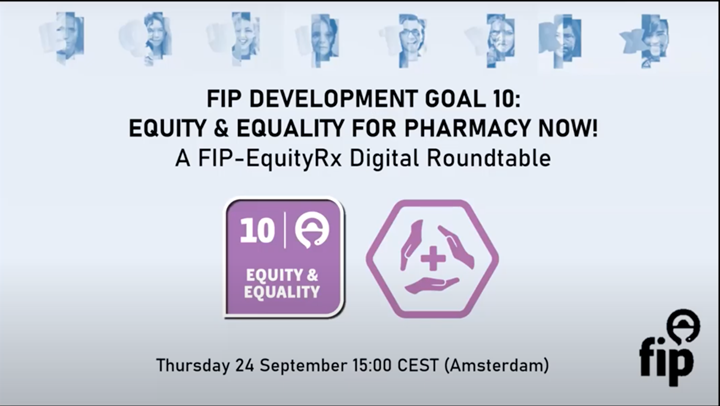

FIP Development Goal 10 Education & Workforce Element
Globally, we will have:
Clear strategies for addressing equity and diversity inequalities in pharmaceutical workforce development, continued education and training, and career progression opportunities.
Mechanisms

FIP Development Goal 10 Practice Element
Globally, we will have:
Clear strategies for equity and diversity in pharmaceutical services delivery, service access and service impact so that all people have access to quality pharmaceutical care.
Mechanisms

FIP Development Goal 10 Science Element
Globally, we will have:
Equity in global capacity of pharmaceutical sciences training, research infrastructure, development and manufacturing capabilities, and evidence-based regulatory oversight.
Mechanisms









The 2020 FIP digital programme, entitled: Transforming Vaccination Globally and Regionally was the first FIP outcome-based online programme of its kind, which culminated in the signing of a FIP Commitment to Action on Improving Vaccination Coverage Through Pharmacies by FIP and member organisations to transform vaccinations globally and regionally. Building on the outcomes of the 2020 programme, the FIP 2021 digital programme focuses on supporting FIP members in accelerating programmes of equity, access and sustainability of vaccinations through policy development and implementation.

Building on World Health Professions Alliance (WHPA), Positive Practice Environments Campaign, the “FIPWiSE toolkit for positive practice environments in education & science” is developed to identify and address inequalities in the workplace environments which affects women in pharmaceutical science and pharmacy education, with transferable learnings across the pharmaceutical workforce. The toolkit is designed to raise awareness and provide possible solutions for individuals, employers and institutions that can enable positive practice environments for women in pharmaceutical science and pharmacy education.
Learning objectives:
1. Explore the key factors that enable positive practice environments for women in pharmaceutical science and pharmacy education, and the entire pharmaceutical workforce
2. Learn about practical solutions for professionals, employers and policy makers in creating positive practice environments for women in pharmaceutical science and pharmacy education
3. Discuss with the toolkit authors and high-level speakers how to take action and stand up for positive practice environments

This event will focus on the role that pharmacists can play in providing pharmaceutical care for people with hearing impairment or a disability linked to hearing loss. Pharmacists must provide clear messages and adapt their communication strategies to this particular population group to ensure optimal use of medicines and medical devices, and they need to have the knowledge and skills to do so. Also, people with hearing loss face different challenges and this problem becomes more relevant with age. Pharmacists can support patients in detecting early signs of hearing loss and taking the appropriate actions.


The new FIP Development Goals which have just launched are set to transform global pharmacy by providing a systematic and integrated framework that can support the transformation of pharmacy practice, science and workforce & education. Of the 21 Goals, FIP Development Goal 10 impacts us all. The Equity & Equality Goal calls for clear strategies to address inequalities in the pharmaceutical workforce, widen access and equity of pharmaceutical care services & access, as well equity in global capacity in pharmaceutical sciences development. Together we will deconstruct Goal 10 for pharmacy, discuss ways we can implement them and how FIP-EquityRx (FIP’s programme on Equity & Equality) is supporting FIP DG 10’s global implementation.
Together we will explore the following questions… and so much more!

Event Info:
Women are often on the frontlines in delivering health care, but health care policy is often led by Men. In an effort to change the narrative during the COVID-19 pandemic, we highlight women taking on leadership roles around the world to make a difference in caring for COVID patients.
Learning objectives:
The following FIP programmes of work and structures support the implementation of this Goal: